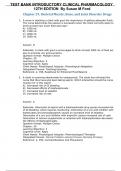Exam (elaborations)
Chapter 29, Skeletal Muscle, Bone, and Joint Disorder Drugs TEST BANK INTRODUCTORY CLINICAL PHARMACOLOGY 12TH EDITION By Susan M Ford
- Course
- Institution
TEST BANK INTRODUCTORY CLINICAL PHARMACOLOGY 12TH EDITION By Susan M Ford 1. A nurse is teaching a client with gout the importance of getting adequate fluids. The nurse determines the session is successful when the client correctly plans to drink at least how much fluid each day? A) 1000 mL ...
[Show more]



